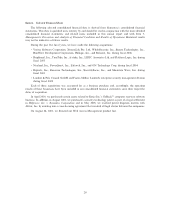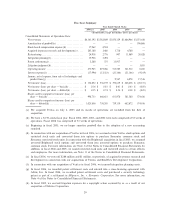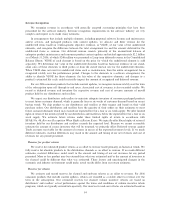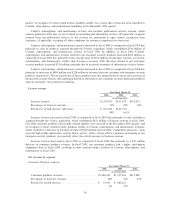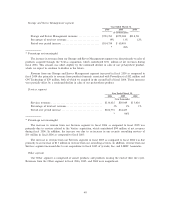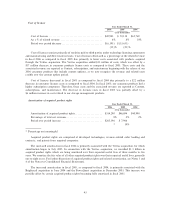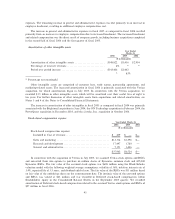Symantec 2006 Annual Report Download - page 42
Download and view the complete annual report
Please find page 42 of the 2006 Symantec annual report below. You can navigate through the pages in the report by either clicking on the pages listed below, or by using the keyword search tool below to find specific information within the annual report.Income Taxes
We are required to estimate our income taxes in each federal, state, and international jurisdiction in
which we operate. This process requires that we estimate the current tax exposure as well as assess temporary
differences between the accounting and tax treatment of assets and liabilities, including items such as accruals
and allowances not currently deductible for tax purposes. The income tax effects of the differences we identify
are classified as current or long-term deferred tax assets and liabilities in our Consolidated Balance Sheets.
Our judgments, assumptions, and estimates relative to the current provision for income tax take into account
current tax laws, our interpretation of current tax laws, and possible outcomes of current and future audits
conducted by foreign and domestic tax authorities. Changes in tax laws or our interpretation of tax laws and
the resolution of current and future tax audits could significantly impact the amounts provided for income
taxes in our Consolidated Balance Sheets and Consolidated Statements of Income. We must also assess the
likelihood that deferred tax assets will be realized from future taxable income and, based on this assessment,
establish a valuation allowance, if required. Our determination of our valuation allowance is based upon a
number of assumptions, judgments, and estimates, including forecasted earnings, future taxable income, and
the relative proportions of revenue and income before taxes in the various domestic and international
jurisdictions in which we operate. To the extent we establish a valuation allowance or change the valuation
allowance in a period, we reflect the change with a corresponding increase or decrease to our tax provision in
our Consolidated Statements of Income.
We failed to timely file the final pre-acquisition tax return for Veritas, and as a result, it is uncertain
whether we can claim a lower tax rate on a dividend made from a Veritas foreign subsidiary under the
American Jobs Creation Act of 2004. We are currently petitioning the IRS for relief to allow us to claim the
lower rate of tax. Because we were unable to obtain this relief prior to filing the Veritas tax return in May
2006, we have paid $130 million of additional U.S. taxes. The potential outcomes with respect to our payment
of this amount include:
‚ If we ultimately obtain relief from the IRS on this matter, the $130 million that we paid in May will be
refunded to us and we will use that amount to reestablish our income tax accrual for the Veritas
transfer pricing disputes.
‚ If we ultimately do not receive relief from the IRS on this matter, and we otherwise have an
adjustment arising from the Veritas transfer pricing disputes, then we would only owe additional tax
with regard to such disputes to the extent that such adjustment is in excess of $130 million.
‚ If we ultimately do not receive relief from the IRS on this matter, and we otherwise do not have an
adjustment arising from the Veritas transfer pricing disputes, then (1) we would be required to adjust
the purchase price of Veritas to reflect a reduction in the amount of pre-acquisition tax liabilities
assumed; and (2) we would be required to recognize an equal amount of income tax expense, up to
$130 million.
Legal Contingencies
From time to time, we are involved in disputes that arise in the ordinary course of business, and we do not
expect this trend to change in the future. We are currently involved in legal proceedings as discussed in
Note 14 of the Notes to Consolidated Financial Statements, as well as other legal matters.
When the likelihood of the incurrence of costs related to our legal proceedings is probable and
management has the ability to estimate such costs, we provide for estimates of external legal fees and any
probable losses through charges to our Consolidated Statements of Income. These estimates have been based
on our assessment of the facts and circumstances at each balance sheet date and are subject to change based
upon new information and intervening events.
Prior to our acquisition of Veritas, Veritas had been in discussions with the staff of the SEC regarding the
SEC's review of certain matters, as described in Note 14 of the Notes to Consolidated Financial Statements,
and based on communications with the staff, Veritas expected these discussions to result in a settlement with
the SEC in which we would be required to pay a $30 million penalty. As part of our accounting for the
36




